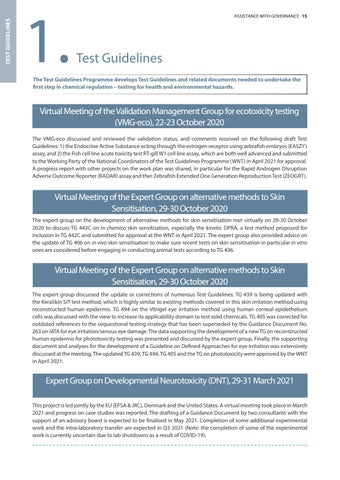TEST GUIDELINES
1.
ASSISTANCE WITH GOVERNANCE . 15
Test Guidelines
The Test Guidelines Programme develops Test Guidelines and related documents needed to undertake the first step in chemical regulation – testing for health and environmental hazards.
Virtual Meeting of the Validation Management Group for ecotoxicity testing (VMG-eco), 22-23 October 2020 The VMG-eco discussed and reviewed the validation status, and comments received on the following draft Test Guidelines: 1) the Endocrine Active Substance acting through the estrogen receptor using zebrafish embryos (EASZY) assay, and 2) the Fish cell line acute toxicity test RT-gill W1 cell line assay, which are both well advanced and submitted to the Working Party of the National Coordinators of the Test Guidelines Programme (WNT) in April 2021 for approval. A progress report with other projects on the work plan was shared, in particular for the Rapid Androgen Disruption Adverse Outcome Reporter (RADAR) assay and ther Zebrafish Extended One Generation Reproduction Test (ZEOGRT).
Virtual Meeting of the Expert Group on alternative methods to Skin Sensitisation, 29-30 October 2020 The expert group on the development of alternative methods for skin sensitisation met virtually on 29-30 October 2020 to discuss TG 442C on in chemico skin sensitisation, especially the kinetic DPRA, a test method proposed for inclusion in TG 442C and submitted for approval at the WNT in April 2021. The expert group also provided advice on the update of TG 406 on in vivo skin sensitisation to make sure recent tests on skin sensitisation in particular in vitro ones are considered before engaging in conducting animal tests according to TG 406.
Virtual Meeting of the Expert Group on alternative methods to Skin Sensitisation, 29-30 October 2020 The expert group discussed the update or corrections of numerous Test Guidelines. TG 439 is being updated with the KeraSkin SIT test method, which is highly similar to existing methods covered in this skin irritation method using reconstructed human epidermis. TG 494 on the Vitrigel eye irritation method using human corneal epidethelium cells was discussed with the view to increase its applicability domain to test solid chemicals. TG 405 was corrected for outdated references to the sequestional testing strategy that has been superseded by the Guidance Document No. 263 on IATA for eye irritation/serious eye damage. The data supporting the development of a new TG on reconstructed human epidermis for phototoxicity testing was presented and discussed by the expert group. Finally, the supporting document and analyses for the development of a Guideline on Defined Approaches for eye irritation was extensively discussed at the meeting. The updated TG 439, TG 494, TG 405 and the TG on phototoxicity were approved by the WNT in April 2021.
Expert Group on Developmental Neurotoxicity (DNT), 29-31 March 2021 This project is led jointly by the EU (EFSA & JRC), Denmark and the United States. A virtual meeting took place in March 2021 and progress on case studies was reported. The drafting of a Guidance Document by two consultants with the support of an advisory board is expected to be finalised in May 2021. Completion of some additional experimental work and the intra-laboratory transfer are expected in Q3 2021 (Note: the completion of some of the experimental work is currently uncertain due to lab shutdowns as a result of COVID-19).










